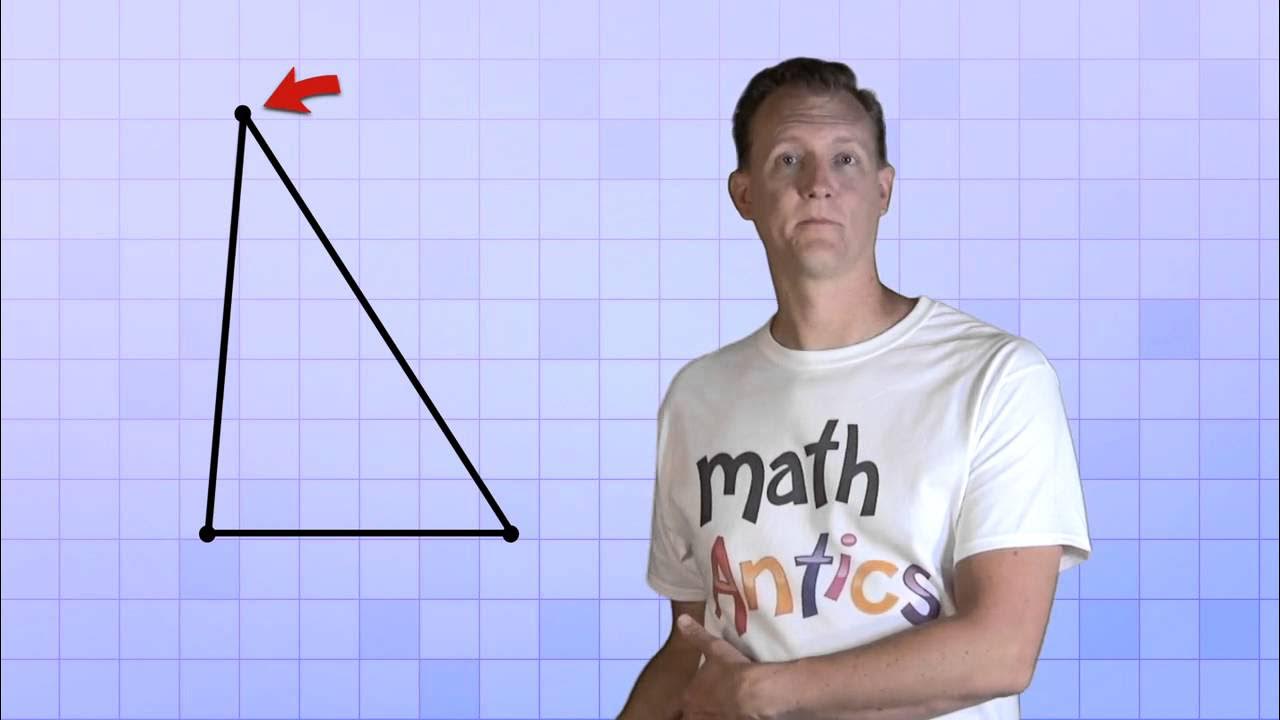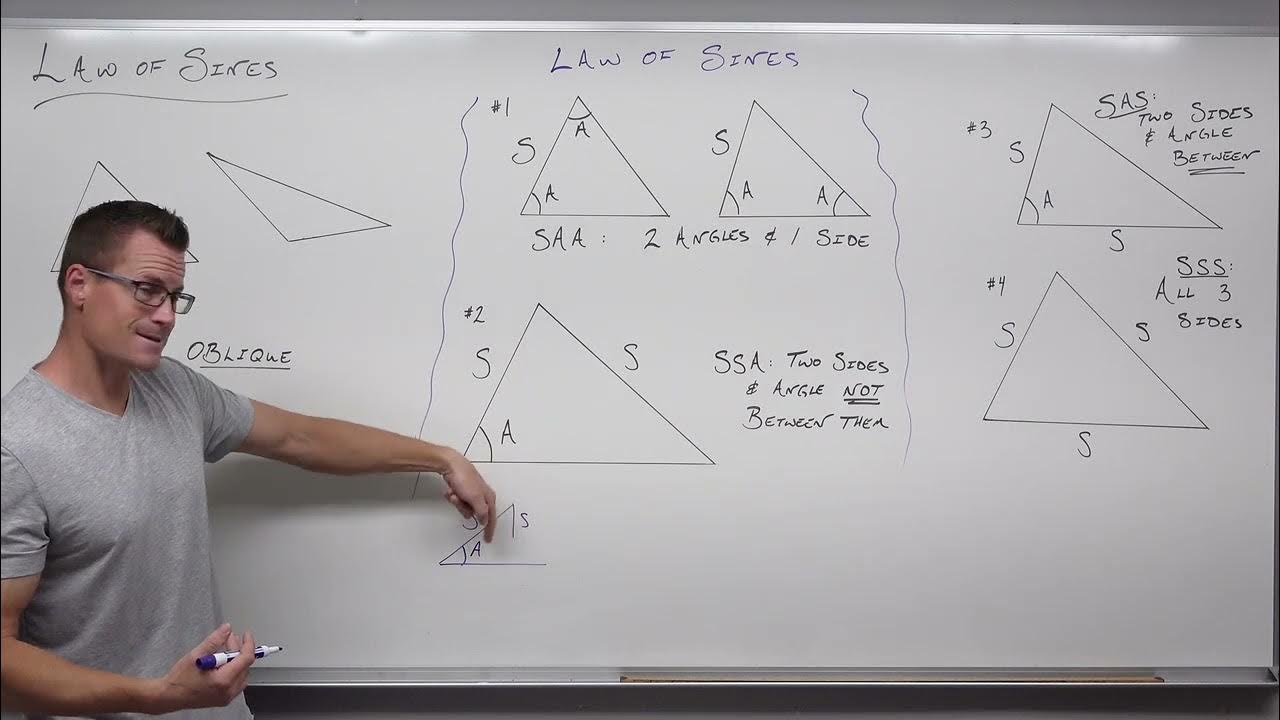Types of Triangles in Euclidean Geometry
TLDRThe script discusses types of triangles, defining acute, obtuse, right, scalene, isosceles, and equilateral triangles. It explains how triangle angles always add to 180 degrees, allowing at most one right or obtuse angle. Special right triangles like 45-45-90 and 30-60-90 are mentioned. The script concludes by demonstrating how geometric rules dictate angle relationships, and how deductive reasoning helps determine missing angles in a diagram.
Takeaways
- 😀 Triangles can be classified by their angles as acute, obtuse or right, based on whether they have angles less than, greater than or equal to 90 degrees.
- 😲 The angles in any triangle always add up to 180 degrees, so there can only be one obtuse or right angle at most.
- 📐 Triangles can also be classified by their side lengths as scalene (no equal sides), isosceles (two equal sides) or equilateral (three equal sides).
- 🔺 Equilateral triangles have three 60 degree angles since they must add up to 180 degrees.
- 🤔 We can use facts about angles, like vertical angles being equal, to fill in missing angles in geometry diagrams.
- ➕ The exterior angle of a triangle equals the sum of the two remote interior angles.
- 🧮 Geometry allows us to ask and answer questions about shapes using logical reasoning based on rules.
- 🚌 Special right triangles like 45-45-90 and 30-60-90 have standard side length ratios.
- 🎯 Applying rules about angle relationships is key to solving geometry problems.
- ☝The study of geometry originated from drawings in sand, much like a brain playground with rules to follow.
Q & A
What are the three main ways to classify triangles based on their angles?
-The three main ways to classify triangles by their angles are: acute triangles (all angles less than 90 degrees), obtuse triangles (one angle greater than 90 degrees), and right triangles (one 90 degree angle).
True or false: an equilateral triangle has three congruent angles.
-True. Since all three sides of an equilateral triangle are congruent, all three angles must also be congruent, each measuring 60 degrees.
What is the key fact about the angles in any triangle that allows us to algebraically determine missing angle measures?
-The key fact is that the three angles in any triangle always add up to 180 degrees. So if we know two angle measures, we can subtract them from 180 to solve for the third angle.
What are the three ways to classify triangles based on their side lengths?
-The three ways to classify triangles by their side lengths are: scalene (no congruent sides), isosceles (two congruent sides), and equilateral (three congruent sides).
What is an exterior angle of a triangle equal to?
-An exterior angle of a triangle is equal to the sum of the two non-adjacent interior angles. This follows from the fact that an exterior angle plus its adjacent interior angle form a straight line, so they must add to 180 degrees.
What are the side lengths and angle measures of a 45-45-90 right triangle?
-A 45-45-90 right triangle has two legs of equal length X and a hypotenuse of length X√2. The two acute angles each measure 45 degrees and the right angle measures 90 degrees.
What theorem allows us to state that vertical angles formed by two intersecting lines are equal?
-The Vertical Angle Theorem states that vertical angles formed by two intersecting lines are equal in measure.
Why can a triangle have at most one obtuse or right angle?
-Since the three angles of a triangle must add to 180 degrees, if there were two obtuse angles or two right angles, their sum would exceed 180 degrees, which is impossible. So only one angle can exceed 90 degrees.
What are adjacent angles and how are they related?
-Adjacent angles share a common side and do not overlap. Adjacent angles always add up to 180 degrees and are called supplementary angles.
What is significant about applying rules of geometry, like those governing triangle angles?
-Applying geometric rules allows us to logically answer questions and reveal truths, much like the ancient Greek mathematicians did using diagrams in sand. It exercises spatial reasoning skills.
Outlines
😀 Introducing Triangles and Angles
The first paragraph introduces the topic of triangles, their different types based on angles and side lengths. It covers key definitions like acute, obtuse, right, scalene, isosceles, and equilateral triangles. An important fact is that angles of a triangle always sum to 180 degrees.
😊 Identifying Triangle Types
The second paragraph explains how to identify different triangle types based on their angle and side length properties. It also introduces special right triangles like 45-45-90 and 30-60-90 triangles.
🤓 Applying Rules to Solve for Unknowns
The third paragraph demonstrates how to leverage rules about angles and side lengths to solve for unknown values in a diagram with triangles. It emphasizes logic and reasoning being central to geometry.
😀 Checking Comprehension on Key Concepts
The final paragraph summarizes that this overview of triangle properties and relationships will be applied constantly in geometry. It suggests checking comprehension on these foundational concepts.
Mindmap
Keywords
💡triangle
💡acute triangle
💡obtuse triangle
💡right triangle
💡scalene triangle
💡isosceles triangle
💡equilateral triangle
💡exterior angle
💡forty-five forty-five ninety triangle
💡thirty-sixty-ninety triangle
Highlights
The study found a significant increase in positive mental health outcomes for participants in the mindfulness program.
Researchers developed a new theoretical model to explain the relationship between childhood trauma and adult depression.
The new polymer material showed enhanced thermal and mechanical properties compared to existing materials.
Statistical analysis revealed a strong correlation between level of education and life expectancy.
Climate change models predict more extreme weather events and rising sea levels over the next 50 years.
Early detection and treatment were found to significantly improve outcomes for patients with the disease.
The drug combination showed promise in initial trials for treating the autoimmune disorder.
Further research is needed to understand the neurological mechanisms underlying the new memory formation findings.
The new surgical technique reduced complication rates and recovery times for patients.
Investing in early childhood education programs could provide significant long-term economic benefits.
The study revealed new insights into social behaviors and relationships among the animal population.
More work is required to address potential ethical concerns surrounding the emerging technology.
The researchers concluded that environmental factors played a greater role than genetic predisposition.
Further testing will determine if the prototype is scalable for commercial applications.
The report provided recommendations to policymakers for improving sustainability practices.
Transcripts
Browse More Related Video

Math Antics - Triangles

A Simple Trick To Remember Trigonometry Values

How To Find The Exact Values of Trig Functions

Trigonometry - How To Solve Right Triangles

How to Use the Law of Sines in Trigonometry (Precalculus - Trigonometry 32)

Reference Angles Trigonometry, In Radians, Unit Circle - Evaluating Trig Functions
5.0 / 5 (0 votes)
Thanks for rating: